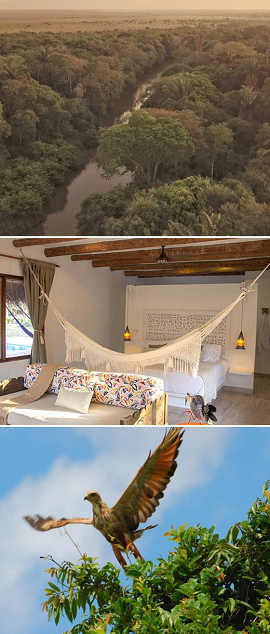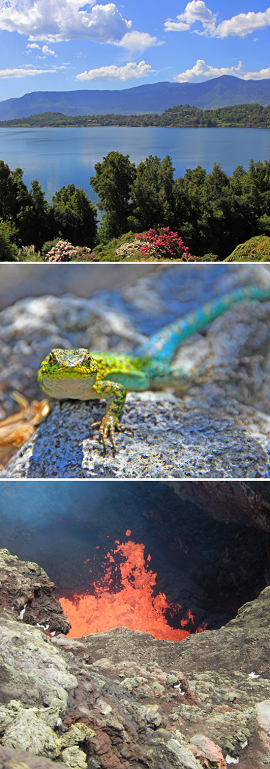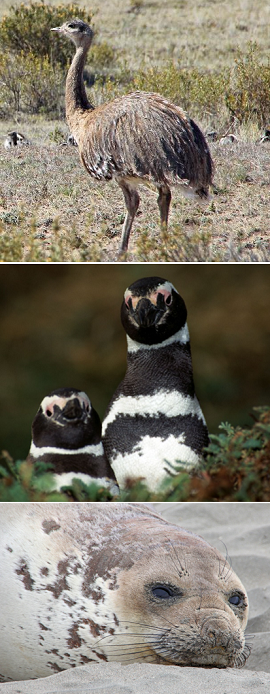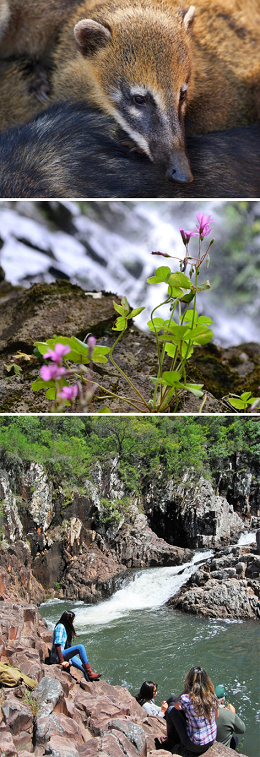|
 |

SAT NEWS - THE GREAT OUTDOORS, PART 2

Dear Travel Partner,
as you probably know, we are proud to have been nominated for the World Travel Awards 2021 in several segments. If you would like to show your support, please take a moment to vote for us! You can register here; voting is open until July 26.
Argentina's Leading Destination Management Company 2021
Peru's Leading Destination Management Company 2021
Uruguay's Leading Destination Management Company 2021
Uruguay's Leading Tour Operator 2021
In this month's newsletter, our second Outdoor edition, we want to bring you up close and personal with South America's breathtaking nature.
There is nothing more exhilarating than exploring spectacular landscapes, observing wildlife in its natural habitat and learning about the different ecosystems in our unique part of the world.
At the same time, spending time outdoors is the perfect way to relax and recharge your energy. Breathing the fresh air, marveling at the majesty of nature and contemplating your place in the world - we guarantee that you will be a whole different person after experiencing this!
We have selected a few ideas to show you the endless possibilities South America has to offer. As always, we are happy to offer more options or create tailor-made experiences for you and your clients. Just contact us!
Enjoy reading and all the best,
your SAT Team
Follow us on Facebook, Instagram and Youtube for more news, products and impressions!

*** Temporary office hours (Monday-Friday) ***
| SAT Argentina: |
9:00 - 13:00 |
SAT Ecuador: |
9:30 - 17:30 |
| SAT Brazil: |
9:00 - 13:00 |
SAT Peru: |
8:00 - 14:00 |
| SAT Chile: |
9:00 - 13:30 |
SAT Uruguay: |
9:30 - 13:30 |
| SAT Colombia: |
9:30 - 17:30 |
|
|
|
 |
|
 |

|
 |
|
 |
|
COLOMBIA: SAVANNA ORINOQUÍA LODGE
|
 |
 |
|
The
Colombian Orinoquía region, also known as the Eastern Plains, is an incredibly diverse landscape that is heavily influenced by the
watershed of the Orinoco River. Its tributaries run through savannas, wetlands and plains, creating a perfect home to a big number of wildlife and plants. The
department of Casanare makes up approx. 27% of the Orinoquía. Despite being only roughly the size of Denmark, Casanare features
16 different ecosystems! They include the floodplain, moor, the altillanura (high lands), the sub-Andean and Andean forests and the rough mountains of the Cordillera Oriental which reaches altitudes of 4,000m (13,123ft).
This is where you find the
Savanna Orinoquía Lodge, located at the shore of the Cravo Sur River. The excursions are perfectly designed to
explore the breathtaking landscape and observe local wildlife, including more than 300 (mostly aquatic) bird species. Among the mammals are anteaters, capybaras, howler monkeys and Sabanero deer. There are also reptiles such as Sabanero turtles and the
critically endangered Orinoco crocodile. You might even spot an anaconda! The rivers carry several species of fish, including the yellow Cachama and catfish. Birdwatchers will want to visit during the
dry season
(Nov-Mar) whereas fans of boat excursions and fishing should aim for the
rainy season
(Apr-Oct).
The luxury lodge offers 6 generously sized bungalows (60m 2), equipped with a king size bed, two twin sofas, a hammock, a stereo and a 55-inch TV; the private bathroom features an outdoor shower. The 41m 2 terrace boasts a private pool, a sitting area, and hammocks. The cuisine focuses on local flavors and preparations, including lots of fresh seafood and fish as well as traditional dishes based on rice and pasta.
The lodge can be reached by car and boat via El Algarrobo or by private plane directly to the lodge's landing strip.
For more information about the Savanna Orinoquía Lodge or other outdoor experiences in Colombia, please contact us!
Picture credit: Savanna Orinoquía Lodge |
 |
|
 |
 |
The Chilean Lake District is truly a feast for the eyes and the soul: volcanoes, caves, waterfalls, hot springs, lava fields, crystal clear waters and millennial Araucarias forests. It is unbelievable that all of this can be found in such a relatively small area!
If you are a nature lover, we suggest you travel to the heart of the Lake District: Pucón. In a short time, you can marvel at the bubbling lava in the crater of the Villarrica volcano - one of the most active in South America, revel in the profound silence of lush forests of Southern Beech and Araucaria trees, listen to the gurgling of rapid rivers and keep an eye out for local wildlife such as the Colocolo opossum and the pudu (world’s smallest deer). The temperate rainforests of this region are the natural habitat of the
endemic but rarely seen kodkod cat, the smallest felid species native to the Americas. Pucón is also a great place for
birdwatchers since splendid species such as Red-backed hawks, Austral pigmy owls and Peregrine falcons can be found here.
Pucón can be easily reached from Santiago with a flight to Temuco. Before heading to your hotel, you can visit the first natural phenomenon:
the volcanic caves of Villarrica. Following the Toltén River, you drive towards the beautiful Villarrica Lake and then head towards the majestic Villarrica volcano. At the volcanic monitoring station you can learn more about volcanic eruptions before embarking on a cave exploration along an illuminated path. The next day, we suggest a hike to the enchanted
“Ojos de Caburgua” waterfall and its striking deep blue lagoon. The hike takes you through unspoiled rainforest and afterwards you can relax at the nearby thermal hot springs in the middle of the woods with the river for company. On day 3, you leave Pucón early and drive across the Andes Mountain Range towards the
Conguillio National Park. Created in 1950, the park’s area covers 60,832ha. Along the way, you will notice the changes in landscapes from deep valleys, lakes, lagoons and lava fields to millennial Araucarias forests with the Llaima Volcano rising in the background. In the national park you can take a hike to the
Conguillio Lagoon to admire its shimmering blue water. From there, you can continue to a viewpoint that offers magnificent panoramic views of the surrounding forest. If you are a lover of adventure sports, plan an extra day to go rafting on Trancura River!
Want to learn more about nature experiences in the Lake District or Chile in general? Contact us here! |
|
 |
 |
|
 |
|
ECUADOR: GALÁPAGOS ISLAND HOPPING
|
 |

|
 |
|
 |
The Galápagos Archipelago, which includes more than 233 islands, islets and rocks, is one of the top destinations in the world to observe wildlife up close and explore the extraordinary landscapes that are the result of volcanic eruptions. Not only its formation history but also the incredible numbers of endemic species make the archipelago truly one of a kind: more than 45 species of birds, 42 of reptiles, 15 of mammals and 79 of fish as well as around 500 plant species are exclusively found in the Galápagos!
In order to fully appreciate the rich flora and fauna in this unique paradise, we recommend visiting several islands and exploring both land and water to experience incredible close encounters with sea lions, iguanas, giant tortoises, various booby species, rays, and a myriad of tropical fish. Our 9-day Island Hopping program shows a few of the options to discover the archipelago. The tour starts in
San Cristóbal, where you visit the
Galápagos National Park Visitor Center for an introduction into the islands' history, ecosystems as well as flora and fauna. Keep your eyes peeled for the endemic Chatham mockingbird and San Cristóbal lava lizard that live on the center's grounds! Afterwards, you walk to
Frigate Bird Hill to observe the magnificent frigate birds. On day 2, you snorkel at
Kicker Rock (“León Dormido”), an important nesting area for red-billed tropicbirds, blue-footed boobies, Nazca boobies, and frigate birds. In the crystal clear water, you can observe Galápagos sharks, white- and black-tipped reef sharks, hammerheads, sea turtles, eagle rays and many tropical fish. You take a ferry to
Santa Cruz the next morning. After your arrival, you kayak down the coast towards
Punta Estrada, along the cliff face and into a narrow passageway that dead-ends in a
tangled mangrove forest. In the afternoon, you visit the
Charles Darwin Research Center to learn about local conservation efforts and take a stroll through an impressive giant prickly-pear cactus forest. In the
breeding center, tiny baby turtles are prepared for their release into the wild. On day 4, you go either
snorkeling or diving, depending on your abilities and experience. You might encounter hammerhead and riff sharks, sea lions, turtles, manta rays, jellyfish and of course numerous types of fish. You take a ferry to Isabela on day 5 and walk to the biggest
Giant Tortoise Breeding Center of the archipelago. Besides observing tortoises of all ages and sizes, you will learn about the reproduction and rearing of giant tortoises and see the work that is being carried out to help recover the wild populations of these species. Afterwards, you head for the
“Pozo de los Flamingos”, a lagoon where you have the rare opportunity to observe flamingos up close. In the afternoon, you go snorkeling at
“Las Tintoreras”, a main breeding site of hundreds of marine iguanas. You can also observe a colony of white tipped reef sharks resting in a lava canal, sometimes accompanied by other sharks and sea lions. On the sandy beaches, sea lions play and relax in the sun. On the way back, there is a chance you might see penguins and blue-footed boobies. On day 6, you take a hike to the
volcanoes Sierra Negra and Chico. Sierra Negra's caldera is the largest in the Galápagos and the second largest in the world! At Volcano Chico, you will see various formations of petrified lava of many different colors and textures. The next morning, you take a boat ride to
“Los Túneles”. The shallow, clear, and calm waters make this spot ideal for snorkeling. Besides observing colorful fish, sea turtles, and sharks, you can also explore the unique geologic formations with arches and tunnels formed by lava flows. On your last full day, you return to
Santa Cruz. In the afternoon, you bike to
“Cerro Mesa” viewpoint to enjoy the magnificent views over Santa Cruz and the nearby islands. You can also walk along a short trail to an impressive collapsed magma chamber. Your last visit is to beautiful white sandy
El Garrapetero beach. Surrounded by mangroves and manzanillo trees, it is perfect for birdwatching: Darwin finches, white-cheeked pintails, black-necked stilts and many other costal birds live here. On day 9, you depart from the airport of Baltra.
Please contact us for more travel ideas to the Galápagos. We will be happy to help you decide between an Island Stay, Island Hopping or cruise! |
 |
|
 |
|
PERU: MANU NATIONAL PARK WITH PANTIACOLLA
|
 |
 |
|
Peru's Manu National Park is a huge 1.5 million-ha tropical treasure trove of an unrivalled variety of animal and plant species. Besides 850 species of birds, visitors have the chance to spot rare species such as giant otters, giant armadillos and jaguars.
Join us on a 7-day expedition from/to Cusco to explore this natural paradise with
Pantiacolla who operate 3 lodges in the park. Your adventure starts early in the morning with an 8-hour bus journey over the Andes, climbing to the highpoint of the Manu Biosphere at about 4000m before descending to the
cloud forest. During a long walk, you can observe many bird species such as paradise tanagers, umbrella birds and golden headed quetzals. There are also colorful butterflies, woolly monkeys and capuchin monkeys. At the
lek of the cock-of-the-rock, you observe the dancing and singing ‘performance’ of the males before heading to the rustic Posada San Pedro. The next morning, you continue the bus journey to the tropical lowland rainforest, stopping to visit a
coca plantation
and a small animal rescue
center. At the foot of the Pantiacolla Mountain Range, you
explore an extensive trail system while keeping an eye out for its over 600 bird species, 8 monkey species, and other mammals such as peccaries, ocelots and bats. At night, you visit Ranacocha (“Frog Lake”) to look for tree frogs, poison dart frogs and others. You spend the night at
Pantiacolla Lodge. On day 3, you continue by boat up the Manu River into the heart of Manu’s Reserved Zone. You will have great views of riverside birds, such as the black skimmer or snowy egret, sunbathing black and white caimans, and maybe capybaras. Your base for the next 2 nights is a camping hut deep in the forest. During the stay, you will walk through virgin forest with giant shihuahuaca, mahogany, Brazil nut and rubber trees. You will explore the lake
Cocha Salvador by catamaran and be on the lookout for colorful birds, such as the agami heron, sun grebe or Amazon kingfisher, spider monkeys and giant otters. You will also visit the lake
Cocha Otorongo, which has a 20m high observation platform overlooking the lake. At night, you explore the forest by torchlight or go moonlight caiman-spotting on the lake. Early on day 5 you go boating down the Manu River to spot the bigger and rarer animals at the river shores: black caimans, tapirs, giant anteaters, sloths or even jaguars. You climb a 42-meter high canopy tower to enjoy excellent views of the rainforest canopy before heading to the
Tambo Blanquillo Lodge for the next 2 nights. At first light on day 6 you head to a macaw lick to watch the dazzling spectacle of hundreds of parrots eating clay, including tui and cobalt-winged parakeets, orange-cheeked parrots, red-and-green macaws and even scarlet or blue-and-yellow macaws. In the afternoon, you visit the
oxbow lake Cocha Camungo for a chance to see the rare pygmy kingfisher and pale-eyed blackbird. On day 7, you are on the boat early in the morning to head downstream to the small mining village Boca Colorado to see firsthand the negative effects of human activities on the delicate ecological balance of the rainforest. On the other side of the Inambari River, your bus is waiting to take you through beautiful cloud and elfin forest back to Cusco.
Want to learn more? Feel free to request additional packages in the spectacular Manu National Park here!
Picture credit: Pantiacolla Tours |
 |
|
 |
|
ARGENTINA: BAHIA BUSTAMANTE LODGE
|
 |
The Patagonian coastal town
Bahia Bustamante offers a variety of
different ecosystems - marine, intertidal, marshes, wetlands and steppe - resulting in an impressive biodiversity. It is a true
marine and land wildlife paradise that deserves a spot on the travel bucket list of every nature lover! 13 types of marine birds nest in Bahia Bustamante, including Magellanic Penguins. There are also two endemic bird species, the Chubut Steamer Duck and the Olrog´s Gull. A huge sea lion colony (up to 4,000 individuals) also attracts killer whales and dolphins. Native land animals include Patagonian maras, lesser rheas, guanacos, armadillos, tinamous and grey foxes.
During the Argentinean summer season (October-April), Bahia Bustamante Lodge welcomes visitors to explore the natural treasures this area has to offer. The opening and closure of the lodge also coincides with the
penguin season in Chubut, one of the most wonderful experiences which allows you to observe a colony of Magellanic penguins tend to their chicks and nests. The lodge offers a great selection of exploration activities in the surroundings, like boat rides to observe marine wildlife. If you want to take a trip to the past don't miss the
Petrified Forest, petrified trees and pieces of wood from 60 million years ago! During the visit, you will also be able to observe steppe wildlife.
Self-guided hikes on the Graviña Peninsula allow you to immerse yourself more fully in the beautiful landscape around you.
Bahia Bustamante Lodge offers 11 simple but comfortable cabins in 3 categories. The main lodge houses the restaurant that specializes in local cuisine based on seaweed, lamb meat, fish & seafood, as well as fruits and vegetables from the on-site organic garden. Sustainability plays an important role in the lodge's operation. The eco-lodge and private wildlife sanctuary has been included in the Patagonia Austral National Park and Blue Patagonia UNESCO Biosphere Reserve.
For more information about Bahia Bustamante Lodge and tour suggestions, please contact us! |
|
 |
 |
|
 |
|
URUGUAY: VALLE DEL LUNAREJO
|
 |
 |
|
The Lunarejo Valley is a
protected natural reserve in the northwestern part of Uruguay, close to the border with Brazil. This area serves as a biological corridor for subtropical species of flora and fauna to enter the country from Brazil. The valley is famous for its breathtaking landscape which is characterized by rivers, creeks and flat-topped hills bordering "quebradas", narrow valleys shaped by river courses. These gorges have formed in basaltic rock, with steep slopes and reliefs, making space for
caves and waterfalls. The region also boasts different types of vegetation such as
grasslands, forests (hill, coastal, gorge) and shrublands. This diverse landscape is home to an abundance of wildlife, including
more than 150 species of birds such as the sharp-tailed grass tyrant, the blue-winged macaw and the broad-winged hawk. Several rare species stand out: among the amphibians the Uruguayan frog and the Devincenzi's toad, among the reptiles the rattlesnake - extinct in the south of the country - and among the mammals the small anteater, the molle-tailed tatú, the margay cat, the coati, the coendú and the guazubirá.
In order to explore the Lunarejo Valley, you can choose between several short trails. Located on a private property in the center of the region, the Boquerón Hill Trail provides you with an unparalleled view of the Lunarejo Valley. With a length of 1.3km (0.8mi), the low-difficulty route is the ideal way to get started. With a similar length of 1.5km (0.9mi), the
Paredones Trail will lead you past rivers, providing ample opportunity for wildlife watching. The
De Los Helechos Trail starts at the historical setting of Masoller and leads downhill to a ravine with a natural pool fed by the Lunarejo River. Along the 1.4km (0.86mi) long route, you have the opportunity to spot large sized species of ferns as well as a variety of birds. The
Balcones de Lunarejo Trail is for everybody who prefers to observe their surroundings from horseback. And for some freshening up, the 1.4km (0.86mi) long path offers a detour down to a ravine area with a waterfall.
In order to visit the Lunarejo Valley, we suggest taking a rental car from Montevideo to Tacuarembó, an ideal gateway to visit the reserve. There are also several interesting stops along the way such as Piriápolis, La Coronilla or Mariscala. For more information and self-drive tour suggestions to the Lunarejo Valley, please contact us!
Picture credit: Intendencia de Rivera |
 |
|
 |
 |
|
No exploration of Brazil's nature and wildlife is complete without a visit to the
Pantanal, one of the
largest freshwater wetland ecosystems in the world! The UNESCO even declared the Pantanal Conservation Area a
World Heritage Site in 2000 because of its incredible biodiversity and incomparable landscape which contains elements of tropical savanna, Amazon rainforest, Atlantic and dry forest and shrubland. Around
80 species of mammals, 650 of birds, 50 of reptiles and 263 of fish can be found here, including
several threatened species such as jaguars, giant armadillos, giant anteaters, giant otters, marsh deer and hyacinth macaws, the largest species of parrot. Since this area is a floodplain, there is also a remarkable diversity of aquatic plants.
A great way to visit this unique part of Brazil is the
Araras Eco Lodge, a pioneer project located on a rural property of 2800 hectares in Pocone (2h-drive from Cuiabá airport). The lodge collaborates with ONGs, universities and federal agencies on
several projects of environmental preservation that focus on species such as the hyacinth macaw or the turquoise-fronted parrot. The Araras Eco Lodge offers 19 rooms with solar energy heated showers, air-conditioning and ceiling fan. In order to maximize the immersive experience with nature, they are not equipped with radio or TV. WI-FI is available in the public areas and there is a swimming pool, a parlor as well as a bar and restaurant.
Their 5-day package with jaguar safari is available from July to October and offers the full experience of the Pantanal. After the transfer to the lodge from Cuiabá airport, you embark on an
introductory walk to learn about the lodge's concept and conservation projects. Afterwards, you climb a
12m (39ft) high observation tower for better views of the stunning surroundings. During a night walk, you can marvel at the sky, unobstructed by light pollution. On day 2, you join a
photo safari to the Clarinho River. While paddling down the river, in a canoe, you can enjoy the view of the
forest and mangroves. With a bit of luck, you might spot a family of giant river otters! In the afternoon, you follow the Howler Monkey trail to the 25m (82ft) high Howler Monkey Tower to keep an eye out for animals and observe the sunset. After dinner, you can join a night drive in
search of nocturnal animals. On day 3, you explore the Pantanal further on horseback, including some flooded areas of the plain, and in the afternoon you have the opportunity to observe a
Jabiru Stork nest. The highlight of your stay awaits on day 4. During a 6-hour boat safari on the Cuiabá River, you will look for the
elusive jaguar, the 3rd biggest feline in the world. On the morning of day 5, you depart the lodge for the airport.
Please contact us for details about Araras Eco Lodge and their packages!
Picture credit: Araras Eco Lodge |
 |
|
 |

|
 |
|
 |

|
 |
|
 |
South American Tours - Global Sales Office
South American Tours GmbH | Kaiserstr. 23 | 60311 Frankfurt am Main | Germany
Phone: +49 (0) 69 4058970 | Fax: +49 (0) 69 40589799
Mail: sales@southamericantours.com | www.southamericantours.com
South American Tours - Sales Office North America
Mail: sales-america@southamericantours.com
Copyright © South American Tours 2012-2021
Imprint
South American Tours de Uruguay Agencia de Viajes S.A. | Buenos Aires 618, Piso 2, Oficina 201 | 11000 Montevideo | Uruguay
Tel.: +59 82 91 60 050 | Fax.: +59 82 91 55 406 | E-mail: info@southamericantours.com
Managing Director: Federico Büker | Registered Office: Montevideo | Local Court: Montevideo | Commercial Register: 1194 (Ministry of Tourism) | VAT identification no.: 215224020014

|
|
Protection of data privacy and cancellation of the subscription:
This message has been sent to [del_10063]klonny@southamericantours.com. If you do not want to receive mails in the future you can unsubscribe by clicking
here.
|
|
|
 |
|
 |
 |
|
|